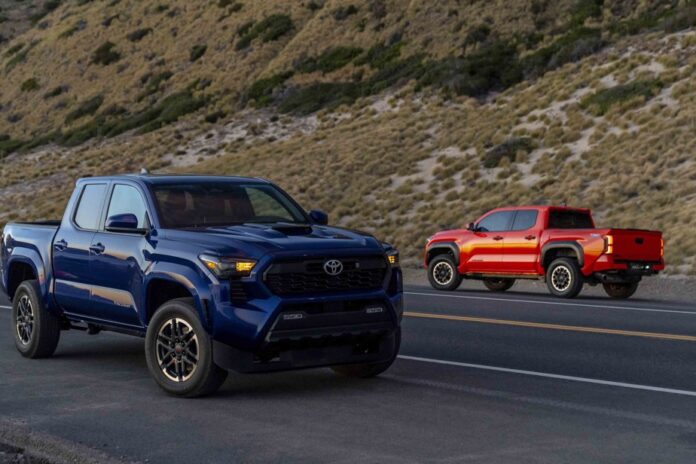A lot has changed in the new Tacoma, but it’s not necessarily obvious. We can understand why. This van has been at the top of the sales charts for a decade now. Its redesign therefore promised to be delicate. How can we subtly balance conservatism and modernity so as not to disorient the faithful? This generation confirms that success is not a formality.
As it should be, this new version offers more than the previous one, which appeared in 2015. We might as well say an eternity ago. Wider and taller, the bodywork is now placed on yet another adaptation of the TNGA-F scale chassis (Tundra, Sequoia). The wheelbase is extended by 115 millimeters, a gain that not only benefits cabin occupants. The tipper also gains in space (8%), robustness (increase in maximum payload) and lightness (14% reduction in weight) with the configuration of this chassis and the use of composite materials.
This fourth generation takes advantage of its size to streamline and strengthen its silhouette. The treatment of the body emphasizes the cut-out of the bumpers or the rounding of the wheel arches and discreetly highlights the contrast effects. The Tacoma puts the shapes there which also have the mission of not resisting the air too much. Hence the presence of a removable front deflector (it can be unclipped during trail excursions). A false good idea. This deflector seems so fragile that we want to hide it forever at the bottom of the shed…
The Tacoma’s new architecture is accompanied by a coil-spring rear axle that improves both dynamic handling and comfort. The noise filtering is remarkable for a model in this category, and even more so its stability on bad surfaces. The “snowshoe hits” on speed bumps and the “wild swaying” on the crevices of a road or a path occur much less violently than in the past.
It’s not just the chassis that makes the new Tacoma more pleasant to live in and drive than the previous generation. The turbocharged 2.4L four-cylinder also has something to do with it. This engine, proven in other products of the brand, produces the same power (278 hp) as the 3.5 L V6 that formerly sat aboard the Tacoma. However, it offers more torque (52 lb-ft), and this at a lower rpm.
This increased liveliness translates into smoother acceleration and pick-ups. Allow about half a second less to reach 100 km/h following a standing start. And unfortunately, there is only a very small impact on consumption, even if the automatic transmission that comes with it has two additional gears (eight instead of six). And the manual transmission, still available although it represents barely 3% of total sales, swallows more gasoline. And it doesn’t really provide any more comfort due to the guidance being too slow and the spacing being too long.
In short, we expected more from this reduction in displacement, and – magically – Toyota has the ready-made solution by directing us towards hybrid engines. More economical (we estimate a gain of just over 1 L/100 km), but more expensive to acquire, Toyota admits. The Japanese manufacturer will announce the prices and consumption ratings of this engine shortly before its marketing scheduled for next spring. The hybrid version (i-Force Max) was not included in the media program for this preview.
The four-wheel drive mode differs depending on the engine selected. On the “all gasoline” versions, this is a temporary device while the one offered with the hybrid propulsion is permanent. The novelty in this department is rather on the side of the detachable stabilizer bar with the aim of improving traction and articulation of the wheels (see our photos) on rough roads. This advancement is included in the catalog of options on practically the entire range, as are tie-down hooks and certain driving aids intended for towing. On this subject, the Tacoma does not tow very heavy compared to many of its rivals.
The completely revised interior (and that’s not a bad thing) claims to have nothing to envy of the competition. The Tacoma favors colored inserts and surrounds (on the most precious liveries), soft-touch coverings, without forgetting the stitching. The central screen (14 inches) appears to have been pinned to the dashboard at the last minute, the left part of which is adorned with several controls that are difficult to identify, especially once night falls. That’s not the important thing.
The Tacoma raises its front seats, our hips are now raised by 30 millimeters and our heels no longer scrape the carpet. Quite a difference. In addition, the steering column is more agile on both axes (tilt and depth).
Unless you are a die-hard fan, the commercial success of the Tacoma remains somewhat of a mystery. This model, which is not very flamboyant, dominates the competition which, however, sometimes puts forward more innovative ideas. The Japanese manufacturer does not want to move away from the design. Bold but cautious, the Tacoma refines the recipe for its success (robustness, reliability, resale value) and carefully avoids deviating from what made it so good. His followers expected no less.















